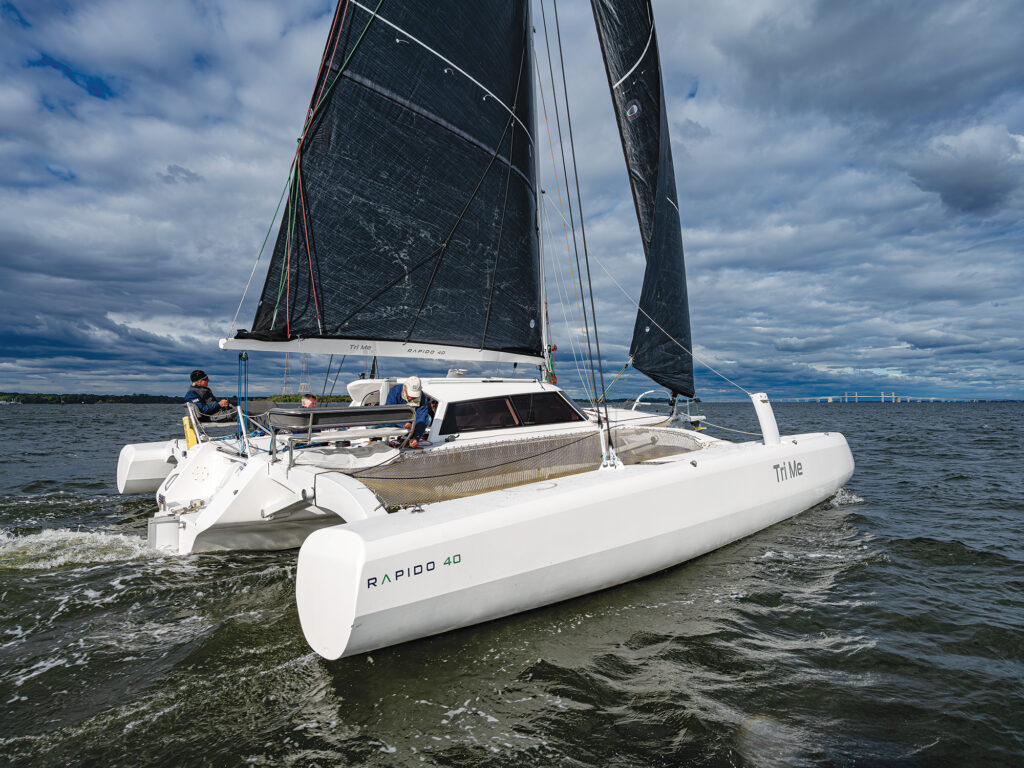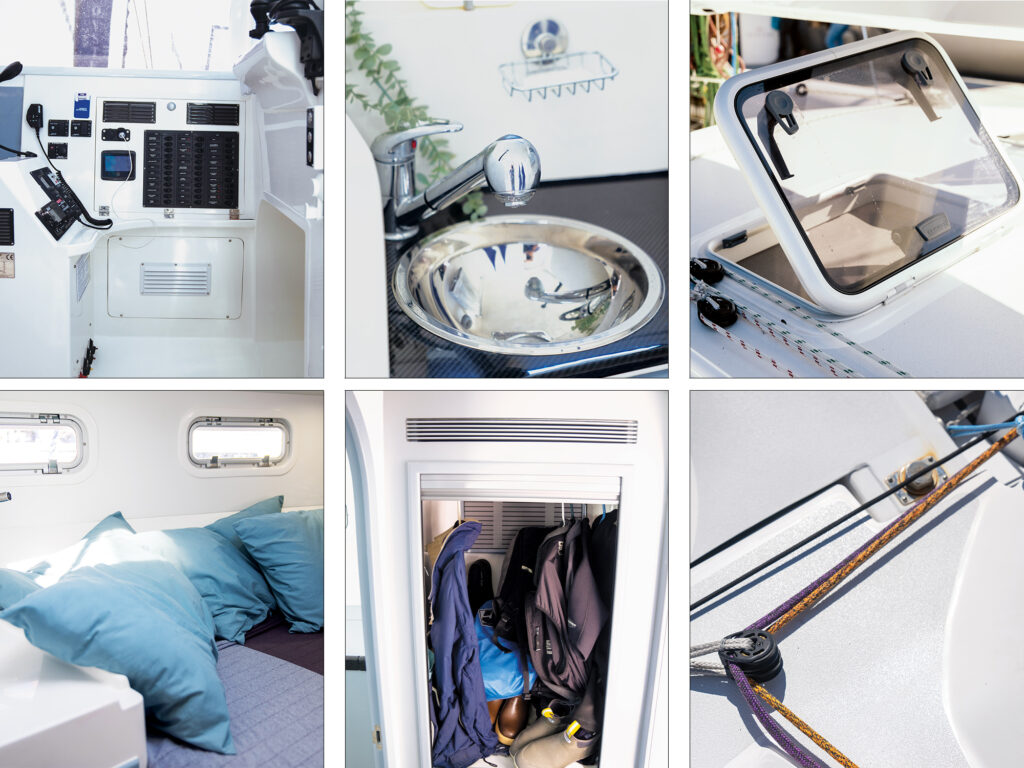
In the great debate among sailors about what’s better—a monohull or a catamaran—both sides make compelling arguments. Monohulls are more efficient at going upwind. Their sufficient ballast ensures stability in a seaway. Some would say that a keelboat is just plain more exciting to sail. But cat lovers counter that they don’t care to “sail on their ear.” They’re willing to motor to windward if necessary, they enjoy the ability to pull up next to a beach, and they rave about the outdoor living space that two hulls afford.
And then there’s the trimaran crowd, which, on a boat like the Rapido 40, gets the best of both worlds. Fast, flat sailing upwind and down? Check. Shallow draft for cruising in skinny water? Check. Lots of room to spread out on deck, and generous accommodations below for a cruising couple with kids or occasional friends? You bet.
The Rapido 40 is designed by the high-performance team at Morrelli & Melvin, and is built in Vietnam by Triac Composites. Rapido was co-founded in 2014 by Paul Koch and Richard Eyre. Koch is an old hand at trimarans—he was formerly president of Corsair—and he says that there is a market out there, albeit a niche one, for performance-oriented, oceangoing cruising trimarans.
Rapido’s 40 is the smallest in a line that ranges upwards of 60 feet—its original model. Just sitting at the dock, the all-carbon-fiber build is one sleek-looking boat. It has a rotating, spreaderless, double-tapered wing mast; a V-shaped boom; and a square-top main that’s paired with a versatile two-headsail sail plan. That sail plan includes a self-tacking jib for upwind sailing or days when it’s blowing, and a screecher set on a sprit. There’s also a continuous-line furler for off-the-wind or light-air conditions.
Underway, that package provides plenty of horsepower, as my Boat of the Year judging colleagues and I would discover on Chesapeake Bay this past fall. It was a ride where we all vied for the dubious honor of top tiller hog.
In 10 to 12 knots with the small jib rolled out, we skipped along at close to 8 knots, according to the GPS. Things got really lively when we rolled up that sail and unfurled the big dog. Twelve knots and change was about top end for us in those relatively light conditions.
And boy, was the Rapido fun to sail! The boat has bench-style seats outboard to either side of the cockpit, so skippers can sit with the tiller extension in hand and legs stretched out, watching the world fly by. C foils in the amas are adjusted up or down depending on the point of sail; strategically placed electric Harken winches raise them, and gravity drops them down. Sheets and halyards can also be led to the winches, so, for a shorthanded crew, sailhandling—especially with the self-tending jib—is pretty simple.
A base model Rapido 40 runs just under $700,000, though the boat we sailed in Annapolis—with top-of-the-line North Sails, B&G electronics and a composting head—carried a price tag of $800,000 and change. Other options include a performance mast and electric propulsion. Lithium batteries are standard.

I’ve been on smaller tris, where the interior can feel cramped because of the relatively narrow beam of the center hull, but the 40 has more-than-adequate living space. An inline galley takes up the starboard side of the salon, with a dining table opposite. The raised cabin top and windows all around provide 360-degree visibility and 6-foot-6-inch headroom. Rear-facing ports are removable for ventilation and to provide better visibility forward from the cockpit. I liked the look of the carbon-fiber countertops and drawers, which felt light as a feather to open. And the composite work was clean as a whistle.
Beneath the cockpit, there’s a double berth that’s accessible through a cockpit hatch or from below. It would be a great place to stash the kids, and two single berths are an option. I’m told that in later models, the cockpit sole has been raised 3 inches, making the aft cabin that much roomier. The owner’s stateroom, with a double berth offset to port, is in a cabin forward of the salon, along with a head and shower.
Hulls and deck are foam-cored. The prepreg autoclave-cured components such as the bulkheads, boom, mast, C foils, structural beams and T-foil rudder are all made in-house. The main hull and amas (which fold in, reducing the beam from 28 feet, 10 inches to 19 feet, 3 inches) all have watertight bow crash compartments. The engine compartment, which houses a 30 hp Yanmar with a shaft drive, is also surrounded by watertight bulkheads, just in case.
Rapido US importer Bob Gleason—an experienced multihull guy and owner of The Multihull Source in Cape Cod, Massachusetts—had fit out the boat that we got aboard to keep the weight down. I still found it packed with all that I’d need for a comfortable getaway. Workmanship and equipment was top-notch, just as I’d expect on a boat built to go places.
Mark Pillsbury is a CW editor-at-large and was a 2024 Boat of the Year judge.








